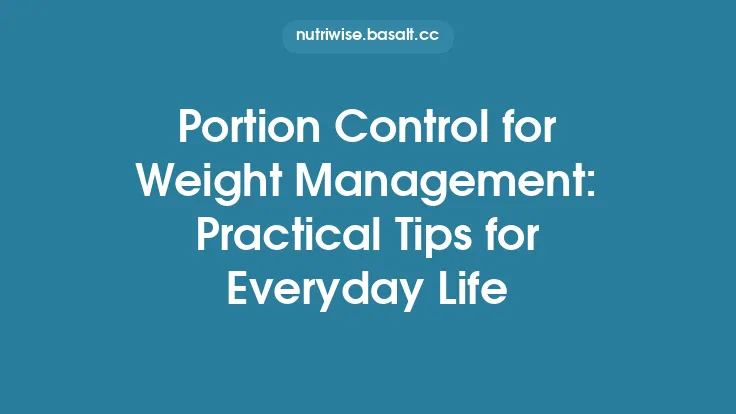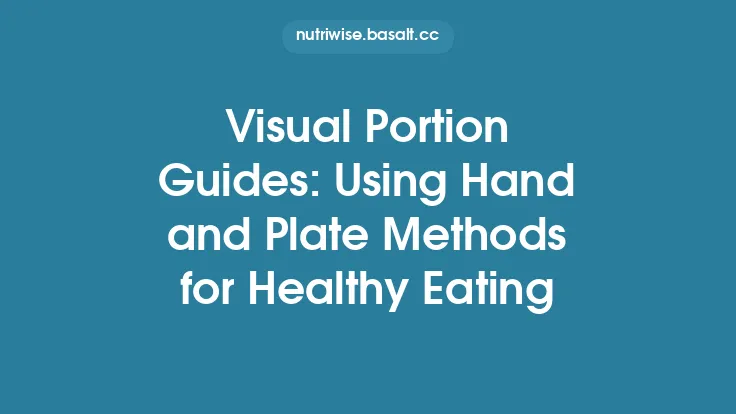Portion control is one of the most practical levers you can pull to improve the quality of your everyday eating without overhauling your entire diet. By mastering a handful of simple strategies, you can keep your meals balanced, support your health goals, and still enjoy the foods you love. Below is a comprehensive guide that walks you through the why and how of portion control, offering actionable steps you can integrate into daily life.
Understanding Portion Sizes in the Context of Everyday Life
Portion size is the amount of food you place on your plate (or in your bowl) at a single eating occasion. While the term “serving size” is often used on nutrition labels, a portion is the actual quantity you decide to consume. The distinction matters because a single serving listed on a package may be far smaller—or larger—than what most people naturally serve themselves.
From a macronutrient perspective, a balanced portion typically includes:
| Macronutrient | Approximate Daily Target* | Typical Portion Size per Meal |
|---|---|---|
| Protein | 0.8–1.2 g per kg body weight | 3–4 oz (≈85–115 g) cooked lean meat, fish, tofu, or legumes |
| Carbohydrates | 45–65 % of total calories | ½ cup cooked grains/pasta, 1 medium fruit, or 1 slice whole‑grain bread |
| Fats | 20–35 % of total calories | 1 tbsp oil, ¼ avocado, or a small handful of nuts |
\*These are general guidelines; individual needs vary based on age, sex, activity level, and health goals.
Understanding these benchmarks helps you gauge whether a plate is proportioned in a way that aligns with your nutritional needs.
Leveraging Meal Planning for Consistent Portions
A well‑structured meal plan removes guesswork. By deciding in advance what you’ll eat for each meal, you can:
- Standardize Recipes – Use a set of go‑to recipes with known ingredient quantities. When a recipe calls for “1 cup of quinoa,” you know exactly how much that contributes to your carbohydrate portion.
- Batch Cook with Intent – Cook larger quantities of staple foods (e.g., brown rice, roasted vegetables) and portion them into individual containers. This creates a library of ready‑to‑eat servings that match your target portion sizes.
- Schedule Snacks – Pre‑designate snack times and decide on the exact foods and amounts (e.g., “1 medium apple + 1 oz cheese”). This prevents impulsive, oversized snacking.
A weekly planning session—whether on Sunday evening or a weekday night—can save time, reduce food waste, and keep portion sizes consistent.
Pre‑portioning Techniques for Home and Work Environments
Even with a solid plan, life can get busy. Pre‑portioning is a safeguard that ensures you have the right amount of food at hand.
- Container Method – Invest in a set of reusable containers with clear volume markings (e.g., ½ cup, 1 cup). Fill each with a specific food group: a ½‑cup container for cooked grains, a 3‑oz container for protein, and a 1‑cup container for vegetables.
- Bag Portioning – For snacks like nuts, seeds, or dried fruit, portion them into small zip‑top bags (≈1 oz). Store these in a drawer for quick grab‑and‑go access.
- Labeling – Write the food name and portion size on each container or bag. This visual cue reinforces the intended serving without requiring mental calculations at the moment.
When you arrive at work or school, you simply pick up the pre‑packaged containers, confident that each aligns with your portion goals.
Strategies for Controlling Portions When Dining Out
Eating out presents unique challenges because you rarely have direct control over the kitchen’s serving sizes. Here are proven tactics:
- Order the Starter as Your Main – Many restaurants serve appetizers that are roughly half the size of a main entrée. Choosing a starter can automatically reduce your portion.
- Ask for a Half‑Portion – Some establishments will accommodate a request for a smaller portion of a dish, especially for proteins and starches.
- Share or Box Half – Immediately after your meal arrives, ask for a to‑go box and set aside half of the plate. This “pre‑portion” technique curtails the temptation to finish everything.
- Prioritize Protein and Veggies – When constructing a plate, fill half with non‑starchy vegetables, a quarter with lean protein, and the remaining quarter with a carbohydrate source. Even without a visual guide, this mental rule helps keep portions balanced.
- Mind the Bread Basket – Limit bread or rolls to one piece, or place them on a separate plate to avoid mindless consumption.
These strategies let you enjoy restaurant meals while staying within your portion framework.
The Role of Protein, Fiber, and Water in Natural Portion Regulation
Certain nutrients naturally promote satiety, helping you feel satisfied with smaller portions:
- Protein – Increases the release of satiety hormones (e.g., peptide YY). Including a source of protein in every meal can reduce overall calorie intake without compromising nutrition.
- Fiber – Slows gastric emptying and adds bulk. Foods high in soluble fiber (e.g., oats, legumes) and insoluble fiber (e.g., leafy greens) create a feeling of fullness.
- Water – Consuming water before or during a meal can expand the stomach’s volume, signaling fullness earlier. A simple habit is to drink a glass of water 15 minutes before eating.
By deliberately incorporating these components, you can naturally curb the urge to over‑serve yourself.
Mindful Eating Practices to Enhance Portion Awareness
Mindfulness isn’t just a buzzword; it’s a scientifically supported method for better portion control.
- Slow Down – Aim to chew each bite 20–30 times. Slower eating extends the time it takes to finish a meal, giving physiological satiety signals a chance to catch up.
- Eliminate Distractions – Turn off screens and focus solely on the act of eating. When attention is divided, it’s easy to lose track of how much you’ve consumed.
- Check In With Hunger Cues – Use a simple 1–10 scale (1 = starving, 10 = uncomfortably full). Stop eating when you reach a 6–7, which typically corresponds to “comfortably satisfied.”
- Portion Review – After each meal, briefly assess the plate: Did you feel satisfied? Was there any food left? This reflection reinforces learning for future meals.
Mindful eating transforms portion control from a rigid rule into an intuitive habit.
Adjusting Portion Sizes Based on Activity Level and Goals
Your energy expenditure fluctuates daily. Aligning portion sizes with activity levels helps maintain balance.
| Activity Level | Recommended Adjustment |
|---|---|
| Sedentary (desk job, minimal exercise) | Keep portions at baseline recommendations. |
| Lightly active (daily walks, light chores) | Add ~½ cup extra vegetables or a small fruit serving. |
| Moderately active (regular cardio, strength training 3–4 times/week) | Increase protein portion by 1–2 oz and add a modest carbohydrate serving (e.g., ¼ cup extra grains). |
| Highly active (intense training, endurance sports) | Consider a larger carbohydrate portion (up to 1 cup) and an additional protein source to support recovery. |
These adjustments are flexible; listen to your body’s hunger and performance cues to fine‑tune portions over time.
Incorporating Portion Control into Snack Choices
Snacks can either sabotage or support your portion goals. Here’s a framework for snack construction:
- Protein + Fiber Pairing – Combine a protein source (e.g., Greek yogurt, a boiled egg, a slice of cheese) with a fiber‑rich item (e.g., berries, carrot sticks). This duo stabilizes blood sugar and prolongs satiety.
- Portion‑Sized Containers – Keep a small container of hummus (≈2 tbsp) and a pre‑cut veggie bag (≈1 cup) ready for quick assembly.
- Timed Snacks – Schedule snacks at consistent intervals (e.g., mid‑morning, mid‑afternoon) to prevent extreme hunger that often leads to larger portions.
By treating snacks as mini‑meals with defined portions, you maintain overall dietary balance.
Using Simple Tools and Habits to Maintain Portion Discipline
You don’t need sophisticated gadgets to stay on track. Simple, low‑tech habits can be just as effective:
- The “Hand” Reference (without formal visual guide) – Use your own hand as a rough gauge: a palm‑sized portion for protein, a cupped hand for carbs, and a fist for vegetables. This mental cue works well when you’re away from measuring devices.
- Plate Division Mental Model – Visualize your plate divided into three zones: half for non‑starchy vegetables, a quarter for protein, and a quarter for carbs. Even without a physical plate guide, this mental image helps you assemble balanced meals.
- Routine Meal Times – Eating at regular intervals trains your body’s hunger signals, reducing the likelihood of overeating during any single meal.
- Pre‑Meal “Check‑In” – Before you sit down, pause for a few seconds to recall your intended portion sizes. This brief mental rehearsal primes you for adherence.
These habits embed portion awareness into everyday routines, making the practice sustainable.
Common Pitfalls and How to Overcome Them
| Pitfall | Why It Happens | Solution |
|---|---|---|
| “All‑You‑Can‑Eat” Buffets | Unlimited options encourage over‑serving. | Fill half the plate with vegetables first, then add modest portions of protein and carbs. Stop when you feel satisfied, not when the plate is empty. |
| Portion Creep | Repeatedly increasing serving sizes over weeks. | Periodically reassess your portions using a kitchen scale or measuring cups to reset baseline sizes. |
| Emotional Eating | Stress or boredom triggers larger portions. | Develop non‑food coping strategies (e.g., short walk, deep‑breathing) and keep a “stress‑snack” list of low‑calorie, high‑satiety options. |
| Relying on “Feeling Full” Alone | Hunger cues can be delayed, leading to over‑eating. | Combine mindful eating with a brief pre‑meal portion check to align intention with action. |
| Skipping Meals | Leads to excessive hunger and larger portions later. | Aim for balanced meals spaced throughout the day to keep hunger manageable. |
Recognizing these traps early allows you to implement corrective actions before they become habits.
Building a Sustainable Portion Control Routine
Sustainability hinges on flexibility, enjoyment, and consistency. Here’s a step‑by‑step blueprint to embed portion control into your lifestyle:
- Set Clear, Personal Goals – Define what you want to achieve (e.g., maintain weight, improve energy, support training). Your portion targets should reflect these goals.
- Create a Baseline – For one week, track the typical amounts you serve yourself using a simple notebook or phone note. Identify patterns of over‑ or under‑portioning.
- Design a Portion Blueprint – Based on your baseline, draft a daily portion template (e.g., 3 oz protein, ½ cup carbs, 1 cup veg per meal). Adjust as needed for activity level.
- Implement Pre‑Portioning – Prepare containers for the upcoming days, aligning each with your blueprint.
- Integrate Mindful Practices – Adopt at least one mindful eating habit (e.g., chew count, hunger scale) and practice it consistently.
- Review Weekly – At the end of each week, evaluate how well you adhered to the blueprint, note any challenges, and tweak the plan.
- Celebrate Small Wins – Recognize successes (e.g., “I stuck to my portion plan for five consecutive days”) to reinforce positive behavior.
By following this iterative process, portion control becomes a dynamic, adaptable part of your daily routine rather than a rigid restriction.
In summary, mastering portion control is less about counting every calorie and more about establishing reliable habits, using simple tools, and aligning food amounts with your body’s needs. With thoughtful planning, mindful execution, and regular reflection, you can enjoy everyday meals that nourish you, support your goals, and fit seamlessly into a busy lifestyle.





